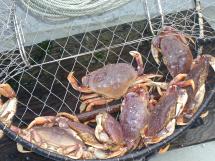ARCHIVED NEWS RELEASE
This document is provided for archival purposes only. Archived documents
do not reflect current WDFW regulations or policy and may contain factual
inaccuracies.
News release Dec. 9, 2020
Dan Ayres, 360-470-3557; Jason Wettstein 360-704-0258
* Update, December 22, 2020: Please see the latest news release on this topic.
New closures expand to both South and Central Coast
OLYMPIA - Effective immediately, the recreational Dungeness crab fisheries on the Washington coast south of the Queets River will close due to elevated marine toxin levels, state shellfish managers announced today.
The Washington Department of Fish and Wildlife (WDFW) expanded closures on crab fishing today (Dec. 9) to include coastal waters stretching from the Queets River to the Columbia River. This closure area includes Grays Harbor and the popular Westport Boat Basin.
The commercial Dungeness crab fishery is also closed and will be delayed until further notice in Washington coastal waters, Grays Harbor, Willapa Bay, and the Columbia River.

WDFW announced the closure after testing showed domoic acid levels in crab exceeded standards for safe consumption established by the Washington State Department of Health (DOH). Domoic acid, a natural toxin produced by certain types of marine algae, can be harmful and even fatal if consumed in sufficient quantities. Cooking or freezing does not destroy domoic acid in shellfish.
The area north of Queets River remains open to recreational crab fishing, as does recreational crab fishing in the Columbia River and in Willapa Bay as of today. Additional crab samples are being collected this week from Willapa Bay and the Columbia River with domoic acid results expected Friday. The agency is continuing to test crabs in coming weeks and will make decisions based on the latest available information.
Levels of domoic acid have been increasing in coastal waters over recent months, said Dan Ayres, WDFW coastal shellfish manager. Earlier this season, the department closed all Washington coastal beaches to razor clam digging due to high levels of the toxin.
“Domoic acid just is not cutting us any breaks in recent weeks and months,” Ayres said. “Closing crabbing areas is not what we want to do right now, but safety has to be our first concern and amnesic shellfish poisoning is not something we or our colleagues at the Department of Health can take lightly.”
DOH will continue to test shellfish in all coastal marine waters. Harvesters can find up-to-date information on seasons and shellfish safety information on the Washington Shellfish Safety Map webpage.
In addition, DOH recommends that crabbers who are fishing outside of the current closure area remove the crab viscera from their catch - to avoid any exposure to possible toxins.
All sport crab gear must be removed from closed areas immediately or it will be subject to confiscation by Fish and Wildlife enforcement officers.
November and December closures represent the first time since 2015 that a crab fishery has been closed in Washington due to domoic acid, Ayres said. The toxin was first detected on the Washington coast in 1991.
Regular testing of shellfish species found in the area - including oysters, hard-shell clams and mussels - shows those shellfish remain safe to eat. The exceptions are razor clams and Dungeness crabs.
The closure will continue until domoic acid levels return to safe levels for consumption.
Harvesters are advised to check the WDFW web page for any updates.
More information about domoic acid can be found on WDFW's domoic acid webpage.